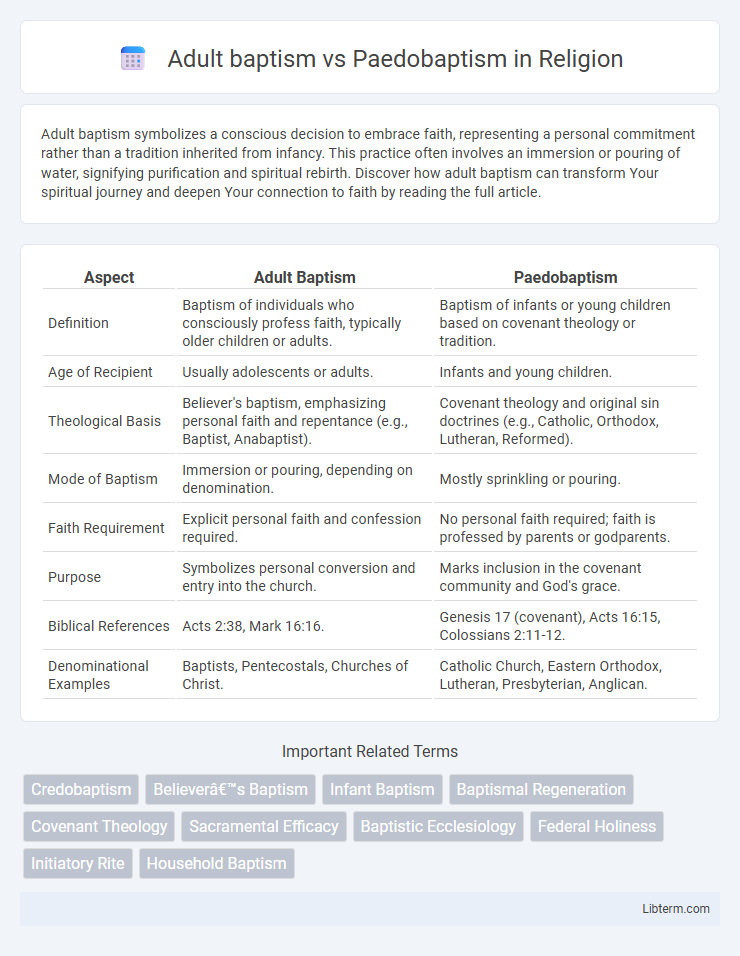Adult baptism symbolizes a conscious decision to embrace faith, representing a personal commitment rather than a tradition inherited from infancy. This practice often involves an immersion or pouring of water, signifying purification and spiritual rebirth. Discover how adult baptism can transform Your spiritual journey and deepen Your connection to faith by reading the full article.
Table of Comparison
| Aspect | Adult Baptism | Paedobaptism |
|---|---|---|
| Definition | Baptism of individuals who consciously profess faith, typically older children or adults. | Baptism of infants or young children based on covenant theology or tradition. |
| Age of Recipient | Usually adolescents or adults. | Infants and young children. |
| Theological Basis | Believer's baptism, emphasizing personal faith and repentance (e.g., Baptist, Anabaptist). | Covenant theology and original sin doctrines (e.g., Catholic, Orthodox, Lutheran, Reformed). |
| Mode of Baptism | Immersion or pouring, depending on denomination. | Mostly sprinkling or pouring. |
| Faith Requirement | Explicit personal faith and confession required. | No personal faith required; faith is professed by parents or godparents. |
| Purpose | Symbolizes personal conversion and entry into the church. | Marks inclusion in the covenant community and God's grace. |
| Biblical References | Acts 2:38, Mark 16:16. | Genesis 17 (covenant), Acts 16:15, Colossians 2:11-12. |
| Denominational Examples | Baptists, Pentecostals, Churches of Christ. | Catholic Church, Eastern Orthodox, Lutheran, Presbyterian, Anglican. |
Introduction to Baptismal Traditions
Adult baptism, also known as believer's baptism, emphasizes personal faith and conscious decision, typically practiced in Baptist and Pentecostal traditions. Paedobaptism, or infant baptism, involves baptizing infants as a sign of covenant inclusion, commonly observed in Lutheran, Reformed, and Catholic churches. These baptismal traditions reflect differing theological views on faith, covenant, and the role of community in spiritual initiation.
Historical Origins of Adult Baptism
Adult baptism, also known as believer's baptism, traces its historical origins to the early Christian movement, emphasizing personal faith and repentance before baptism. This practice was prominent among groups like the Anabaptists during the 16th-century Reformation, who rejected infant baptism and insisted on conscious confession of faith by the baptized individual. The New Testament contains multiple narratives suggesting baptism followed personal belief, contrasting with the early church's gradual adoption of paedobaptism, which became widespread after the third century.
Historical Roots of Paedobaptism
Paedobaptism traces its historical roots to early Christian communities where household baptisms were common, reflecting the practice of baptizing entire families, including infants. This tradition gained theological foundation through interpretations of covenantal continuity between Old Testament circumcision and New Testament baptism, asserting infants as members of God's covenant community. Early Church Fathers like Origen and Augustine supported infant baptism, cementing its place in Christian sacramental practice by the 4th century.
Key Theological Distinctions
Adult baptism emphasizes believer's personal faith and conscious repentance before baptism, symbolizing spiritual rebirth and commitment to Christ. Paedobaptism, practiced in many Reformed and Catholic traditions, views baptism as a covenantal sign analogous to circumcision, signifying inclusion in the community of faith from infancy. Key theological distinctions involve the understanding of faith, covenant, and the regenerative role of baptism in relation to individual belief and church membership.
Scriptural Basis for Adult Baptism
Adult baptism finds strong scriptural support in passages such as Acts 2:38, where repentance precedes baptism, emphasizing conscious faith decisions. The examples of baptisms in the New Testament consistently involve individuals capable of personal belief, like the Ethiopian eunuch in Acts 8:36-38 and the jailer in Acts 16:31-33. This focus on believer's baptism underscores the importance of a personal confession of faith before the baptismal act.
Scriptural Arguments for Paedobaptism
Scriptural arguments for paedobaptism emphasize covenant continuity, citing household baptisms in Acts 16:15, 33 and 1 Corinthians 1:16 as evidence that entire families, including children, received baptism. Passages like Genesis 17:7 present circumcision as a sign of the covenant extended to believers and their offspring, which paedobaptists argue baptism now replaces as the covenant sign (Colossians 2:11-12). Furthermore, Jesus' welcoming of children in Mark 10:14 supports the inclusion of infants in the community of faith and its sacramental practices.
Symbolic Meanings and Doctrinal Implications
Adult baptism symbolizes personal faith, repentance, and conscious commitment, representing a believer's public declaration of salvation and spiritual rebirth. Paedobaptism signifies covenant inclusion, grace, and communal identity, reflecting the theology of original sin and the continuation of the Abrahamic covenant through infant initiation. Doctrinal implications of adult baptism emphasize individual accountability and evangelical conversion, whereas paedobaptism underscores sacramental grace and ecclesial belonging from birth.
Denominational Practices and Perspectives
Adult baptism, practiced by denominations such as Baptists and Pentecostals, emphasizes believer's baptism, requiring a personal confession of faith before full immersion. Paedobaptism, common in Catholic, Orthodox, Lutheran, and Reformed churches, involves baptizing infants as a sign of covenant inclusion and grace, often by sprinkling or pouring water. The theological perspectives differ, with adult baptism highlighting conscious commitment and paedobaptism stressing God's covenantal promise and community incorporation.
Contemporary Debates and Controversies
Contemporary debates on adult baptism versus paedobaptism center on theological interpretations of baptismal efficacy and covenant theology, with adult baptism emphasizing personal faith and conscious repentance, while paedobaptism underscores covenantal inclusion and grace extended to infants. Conflicts arise in ecclesiastical settings over ecclesiology and sacramental theology, particularly regarding church membership, regeneration, and the role of baptism in salvation. Digital forums and theological publications intensify these controversies, reflecting diverse denominational stances from Baptist communities advocating believers' baptism to Reformed traditions upholding infant baptism.
Conclusion: Navigating the Baptism Debate
Adult baptism emphasizes personal faith confession and conscious commitment, aligning with believer's baptism principles, whereas paedobaptism supports infant baptism as a sign of covenant inclusion and community identity. Both practices reflect deep theological convictions about salvation, faith, and church membership within different Christian traditions. Navigating the baptism debate requires understanding historical contexts, doctrinal foundations, and the spiritual significance each form holds for diverse congregations.
Adult baptism Infographic

 libterm.com
libterm.com